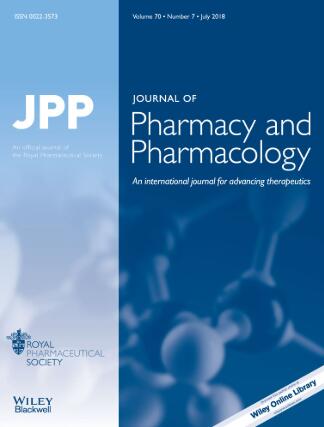Homoharringtonine promotes non-small-cell lung cancer cell death via modulating HIF-1α/ERβ/E2F1 feedforward loop
IF 2.8
4区 医学
Q2 PHARMACOLOGY & PHARMACY
引用次数: 0
Abstract
Objectives Hypoxia conditions promote the adaptation and progression of non-small-cell lung cancer (NSCLC) via hypoxia-inducible factors (HIF). HIF-1α may regulate estrogen receptor β (ERβ) and promote the progression of NSCLC. The phytochemical homoharringtonine (HHT) exerts strong inhibitory potency on NSCLC, with molecular mechanism under hypoxia being elusive. Methods The effects of HHT on NSCLC growth were determined by cell viability assay, colony formation, flow cytometry, and H460 xenograft models. Western blotting, molecular docking program, site-directed mutagenesis assay, immunohistochemical assay, and immunofluorescence assay were performed to explore the underlying mechanisms of HHT-induced growth inhibition in NSCLC. Key findings HIF-1α/ERβ signaling-related E2F1 is highly expressed and contributes to unfavorable survival and tumor growth. The findings in hypoxic cells, HIF-1α overexpressing cells, as well as ERβ- or E2F1-overexpressed and knockdown cells suggest that the HIF-1α/ERβ/E2F1 feedforward loop promotes NSCLC cell growth. HHT suppresses HIF-1α/ERβ/E2F1 signaling via the ubiquitin-proteasome pathway, which is dependent on the inhibition of the protein expression of HIF-1α and ERβ. Molecular docking and site-directed mutagenesis revealed that HHT binds to the GLU305 site of ERβ. HHT inhibits cell proliferation and colony formation and promotes apoptosis in both NSCLC cells and xenograft models. Conclusion The formation of the HIF-1α/ERβ/E2F1 feedforward loop promotes NSCLC growth and reveals a novel molecular mechanism by which HHT induces cell death in NSCLC.高百部碱通过调节 HIF-1α/ERβ/E2F1 前馈环路促进非小细胞肺癌细胞死亡
目的 低氧条件通过低氧诱导因子(HIF)促进非小细胞肺癌(NSCLC)的适应和进展。HIF-1α 可调控雌激素受体 β(ERβ)并促进 NSCLC 的进展。植物化学物质高百部碱(HHT)对 NSCLC 有很强的抑制作用,但缺氧条件下的分子机制尚不清楚。方法 通过细胞活力测定、集落形成、流式细胞术和 H460 异种移植模型测定 HHT 对 NSCLC 生长的影响。通过 Western 印迹分析、分子对接程序、定点突变分析、免疫组化分析和免疫荧光分析来探讨 HHT 诱导 NSCLC 生长抑制的内在机制。主要发现 HIF-1α/ERβ 信号相关的 E2F1 高表达,并导致不利的生存和肿瘤生长。在缺氧细胞、HIF-1α过表达细胞以及ERβ或E2F1过表达和敲除细胞中的研究结果表明,HIF-1α/ERβ/E2F1前馈环促进了NSCLC细胞的生长。HHT通过泛素-蛋白酶体途径抑制HIF-1α/ERβ/E2F1信号传导,而这依赖于对HIF-1α和ERβ蛋白表达的抑制。分子对接和定点突变显示,HHT 与 ERβ 的 GLU305 位点结合。在 NSCLC 细胞和异种移植模型中,HHT 都能抑制细胞增殖和集落形成,并促进细胞凋亡。结论 HIF-1α/ERβ/E2F1 前馈环的形成促进了 NSCLC 的生长,并揭示了 HHT 在 NSCLC 中诱导细胞死亡的新分子机制。
本文章由计算机程序翻译,如有差异,请以英文原文为准。
求助全文
约1分钟内获得全文
求助全文
来源期刊
CiteScore
6.60
自引率
0.00%
发文量
91
审稿时长
3 months
期刊介绍:
JPP keeps pace with new research on how drug action may be optimized by new technologies, and attention is given to understanding and improving drug interactions in the body. At the same time, the journal maintains its established and well-respected core strengths in areas such as pharmaceutics and drug delivery, experimental and clinical pharmacology, biopharmaceutics and drug disposition, and drugs from natural sources. JPP publishes at least one special issue on a topical theme each year.

 求助内容:
求助内容: 应助结果提醒方式:
应助结果提醒方式:


